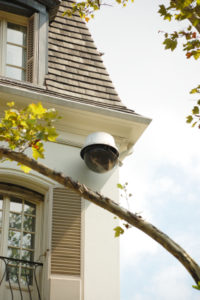
Residential security cameras are a proven tool for deterring crime and theft. With the advent of newer technologies, homeowners and renters have more choices than ever before when it comes to safeguarding their assets both in and outside of the home. Strategically placed camera surveillance can catch prowlers in action, providing concrete evidence should a break-in occur.
Before investing your hard-earned money on a surveillance system for your residence, there are a few important things to consider first.
Camera placement – indoors or outdoors?
Often, just spotting a security camera is enough to make a burglar move on to another, easier target. Outdoor security surveillance cameras are terrific for perimeter security and providing a strong deterrent against would-be intruders. Consider that nearly 70 percent of all home robberies are done using the front or back door. By installing visible video cameras at all ingress points, including windows, criminals will know right away that your property is being monitored and probably think twice.
Indoor cameras are often used to keep an extra set of eyes on pets, children, employees and elderly parents while homeowners are away. Many of today’s indoor cameras feature motion detection, night vision and remote monitoring capabilities.
Wired or wireless?
There is a popular misconception about wireless video surveillance systems. While wireless camera systems have considerably fewer cables, they still need a power source to run and record video 24/7. The term “wireless” refers to how the images are transmitted, allowing homeowners to monitor the property remotely.
For outdoor applications, many homeowners turn to IP cameras for overall performance, quality and durability. IP cameras send high-resolution images over an Ethernet cable, and are powered by an NVR, which holds video for up to 30 days.
Video Quality
Poor image quality is a common complaint about home security cameras, particularly ones that are sold in inexpensive surveillance packages. The majority of today’s mid-range cameras offer clear, crisp images in both day and night scenarios. There are two main factors that impact image quality: resolution and frame rates. Higher resolution images (measured in number of pixels) let you digitally zoom in to enlarge pictures and see detail. Look for systems that are 1080p and higher HD video resolutions.
Image quality is also influenced by the number of frames per second (FPS) the camera records. Cameras that record at least 10 frames per second with decent video quality are usually sufficient. Lower frame rates do have some advantages, as cameras with 30fps or higher will not only be more expensive, they may consume additional memory space on the DVR or NVR.
Home security camera installation
When it comes to the security of your home and family, installing video surveillance can offer great peace of mind.
Learn more about residential surveillance systems designed and installed by Maryland Security Professionals. Request a free security audit by calling 410-514-8426.
